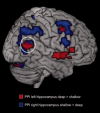The relationship between level of processing and hippocampal-cortical functional connectivity during episodic memory formation in humans
- PMID: 22042493
- PMCID: PMC6870091
- DOI: 10.1002/hbm.21435
The relationship between level of processing and hippocampal-cortical functional connectivity during episodic memory formation in humans
Abstract
New episodic memory traces represent a record of the ongoing neocortical processing engaged during memory formation (encoding). Thus, during encoding, deep (semantic) processing typically establishes more distinctive and retrievable memory traces than does shallow (perceptual) processing, as assessed by later episodic memory tests. By contrast, the hippocampus appears to play a processing-independent role in encoding, because hippocampal lesions impair encoding regardless of level of processing. Here, we clarified the neural relationship between processing and encoding by examining hippocampal-cortical connectivity during deep and shallow encoding. Participants studied words during functional magnetic resonance imaging and freely recalled these words after distraction. Deep study processing led to better recall than shallow study processing. For both levels of processing, successful encoding elicited activations of bilateral hippocampus and left prefrontal cortex, and increased functional connectivity between left hippocampus and bilateral medial prefrontal, cingulate and extrastriate cortices. Successful encoding during deep processing was additionally associated with increased functional connectivity between left hippocampus and bilateral ventrolateral prefrontal cortex and right temporoparietal junction. In the shallow encoding condition, on the other hand, pronounced functional connectivity increases were observed between the right hippocampus and the frontoparietal attention network activated during shallow study processing. Our results further specify how the hippocampus coordinates recording of ongoing neocortical activity into long-term memory, and begin to provide a neural explanation for the typical advantage of deep over shallow study processing for later episodic memory.
Copyright © 2011 Wiley Periodicals, Inc.
Figures






Similar articles
-
A functional magnetic resonance imaging study mapping the episodic memory encoding network in temporal lobe epilepsy.Brain. 2013 Jun;136(Pt 6):1868-88. doi: 10.1093/brain/awt099. Epub 2013 May 14. Brain. 2013. PMID: 23674488 Free PMC article.
-
Cortical pattern separation and item-specific memory encoding.Neuropsychologia. 2016 May;85:256-71. doi: 10.1016/j.neuropsychologia.2016.03.026. Epub 2016 Mar 24. Neuropsychologia. 2016. PMID: 27018483
-
Dissociable effects of top-down and bottom-up attention during episodic encoding.J Neurosci. 2011 Aug 31;31(35):12613-28. doi: 10.1523/JNEUROSCI.0152-11.2011. J Neurosci. 2011. PMID: 21880922 Free PMC article.
-
Age differences in the neural correlates of novelty processing: The effects of item-relatedness.Brain Res. 2015 Jul 1;1612:2-15. doi: 10.1016/j.brainres.2014.08.006. Epub 2014 Aug 19. Brain Res. 2015. PMID: 25149192 Review.
-
Brain networks underlying episodic memory retrieval.Curr Opin Neurobiol. 2013 Apr;23(2):255-60. doi: 10.1016/j.conb.2012.11.005. Epub 2012 Dec 1. Curr Opin Neurobiol. 2013. PMID: 23206590 Free PMC article. Review.
Cited by
-
Top-down modulation of hippocampal encoding activity as measured by high-resolution functional MRI.Neuropsychologia. 2013 Aug;51(10):1829-37. doi: 10.1016/j.neuropsychologia.2013.06.026. Epub 2013 Jul 6. Neuropsychologia. 2013. PMID: 23838003 Free PMC article.
-
Hippocampal Functions Modulate Transfer-Appropriate Cortical Representations Supporting Subsequent Memory.J Neurosci. 2024 Jan 3;44(1):e1135232023. doi: 10.1523/JNEUROSCI.1135-23.2023. J Neurosci. 2024. PMID: 38050089 Free PMC article.
-
Single-Trial Phase Entrainment of Theta Oscillations in Sensory Regions Predicts Human Associative Memory Performance.J Neurosci. 2018 Jul 11;38(28):6299-6309. doi: 10.1523/JNEUROSCI.0349-18.2018. Epub 2018 Jun 13. J Neurosci. 2018. PMID: 29899027 Free PMC article.
-
Extinction of Conditioned Fear in Adolescents and Adults: A Human fMRI Study.Front Hum Neurosci. 2018 Jan 8;11:647. doi: 10.3389/fnhum.2017.00647. eCollection 2017. Front Hum Neurosci. 2018. PMID: 29358913 Free PMC article.
-
Ventral fronto-temporal pathway supporting cognitive control of episodic memory retrieval.Cereb Cortex. 2015 Apr;25(4):1004-19. doi: 10.1093/cercor/bht291. Epub 2013 Oct 31. Cereb Cortex. 2015. PMID: 24177990 Free PMC article.
References
-
- Badre D, Wagner AD ( 2007): Left ventrolateral prefrontal cortex and the cognitive control of memory. Neuropsychologia 45: 2883–2901. - PubMed
-
- Baker JT, Sanders AL, Maccotta L, Buckner RL ( 2001): Neural correlates of verbal memory encoding during semantic and structural processing tasks. Neuroreport 12: 1251–1256. - PubMed
-
- Blaxton TA ( 1989): Investigating dissociations among memory measures: Support for a transfer‐appropriate processing framework. J Exp Psychol Learn Mem Cognit 15: 657–668.
-
- Blaxton TA, Theodore WH ( 1997): The role of the temporal lobes in recognizing visuospatial materials: Remembering versus knowing. Brain Cogn 35: 5–25. - PubMed
Publication types
MeSH terms
LinkOut - more resources
Full Text Sources

